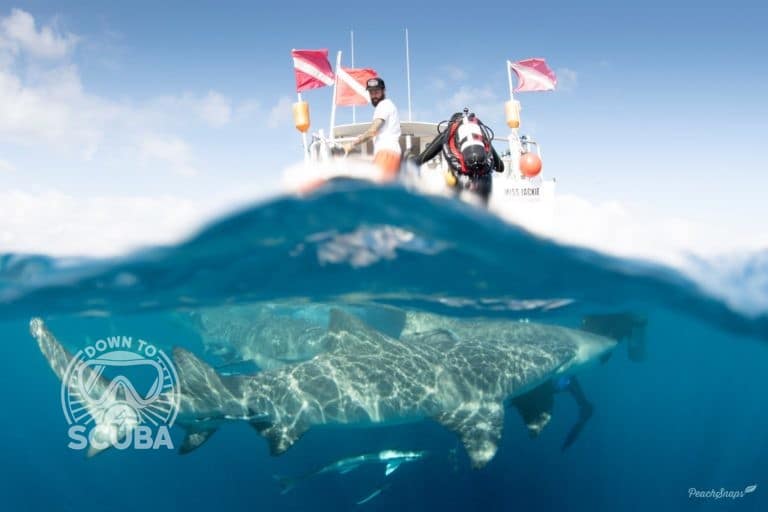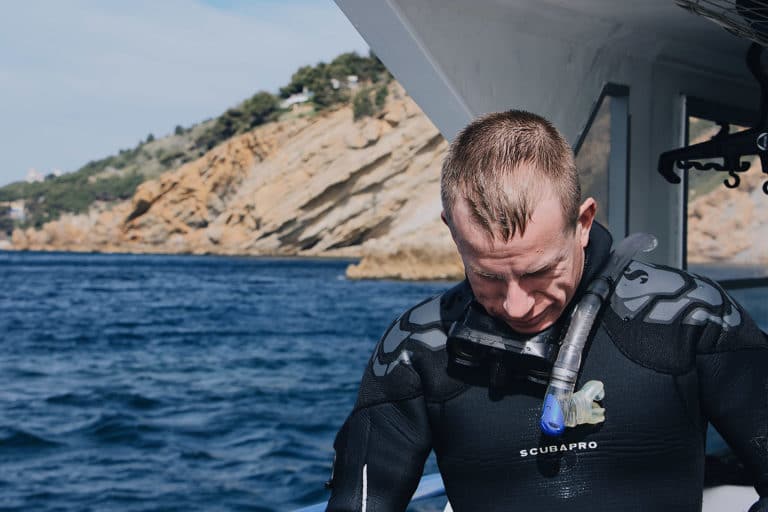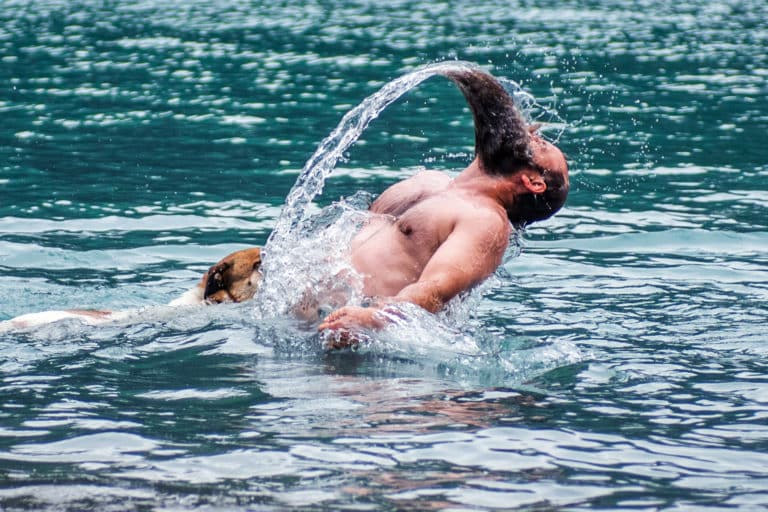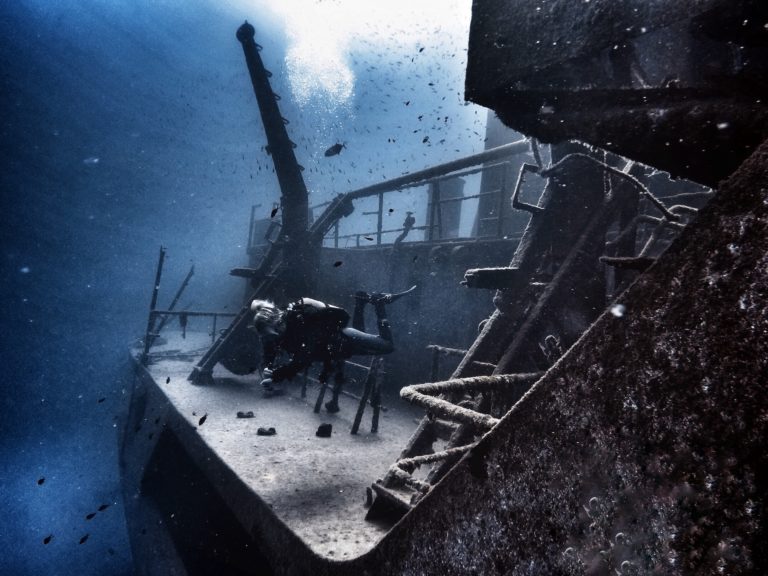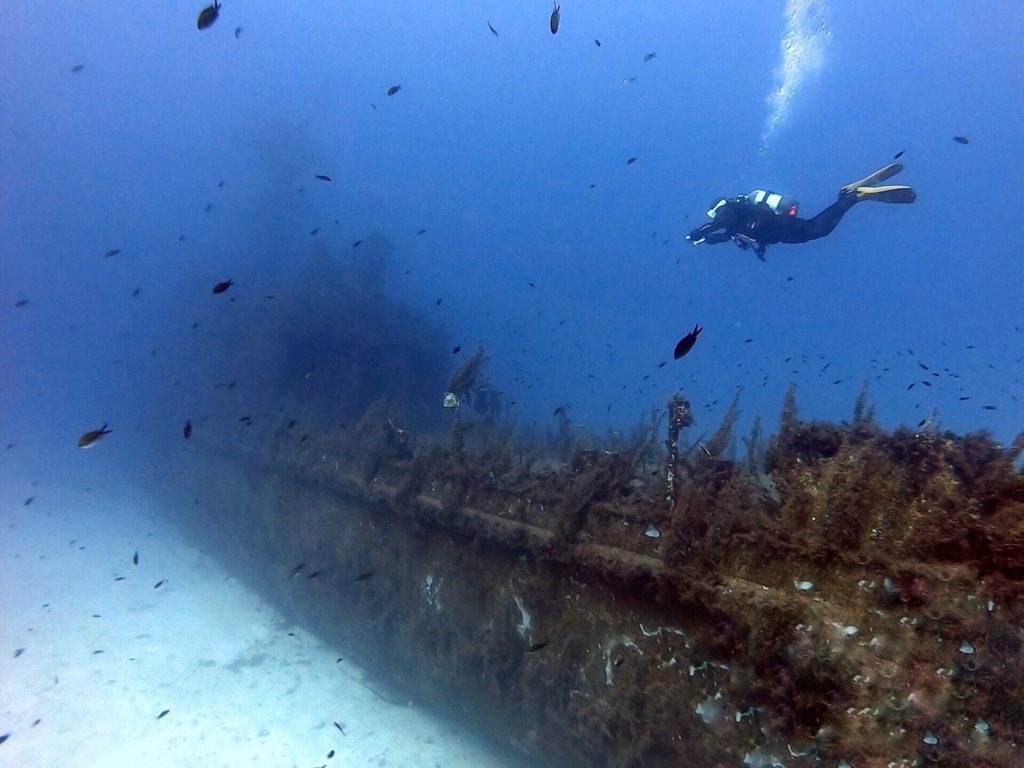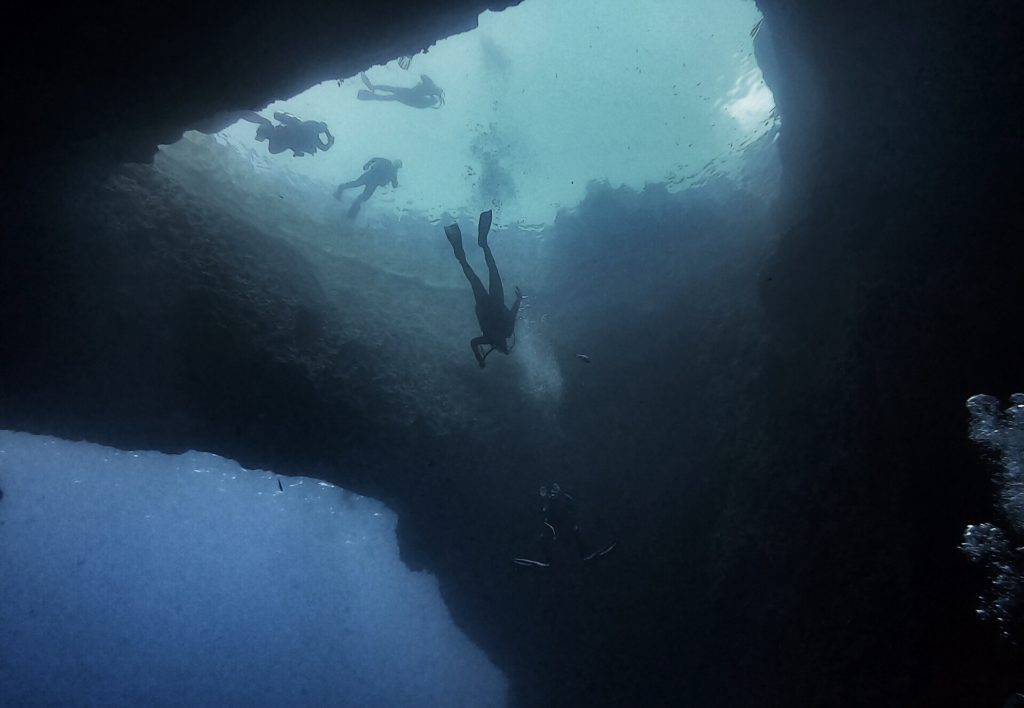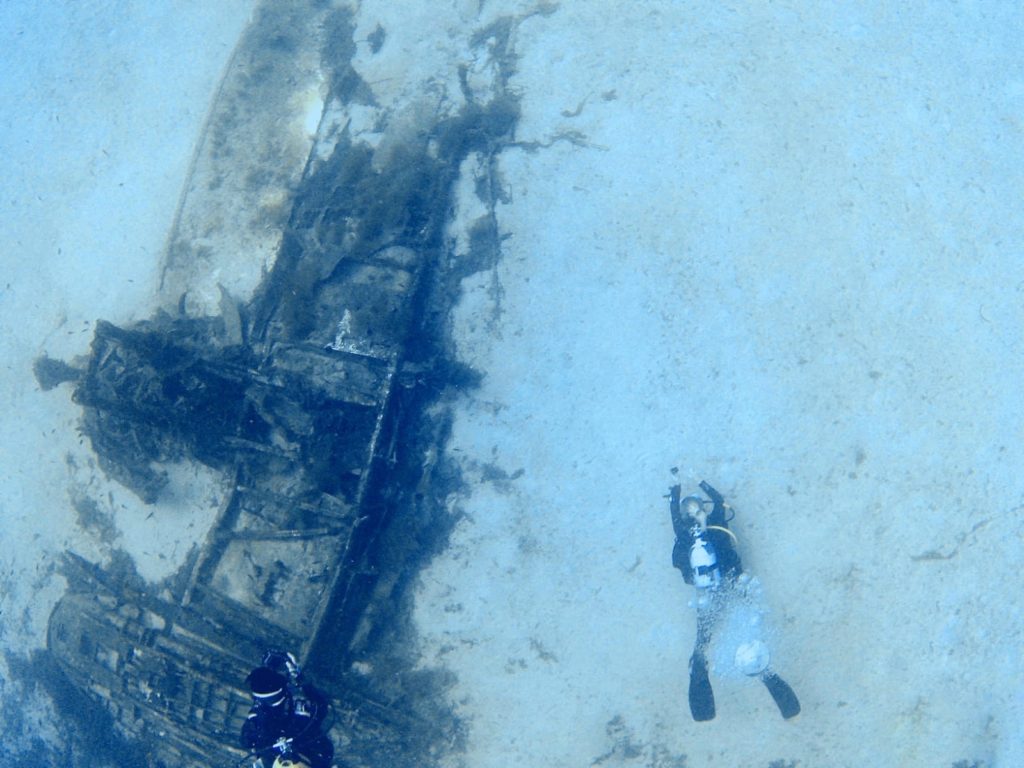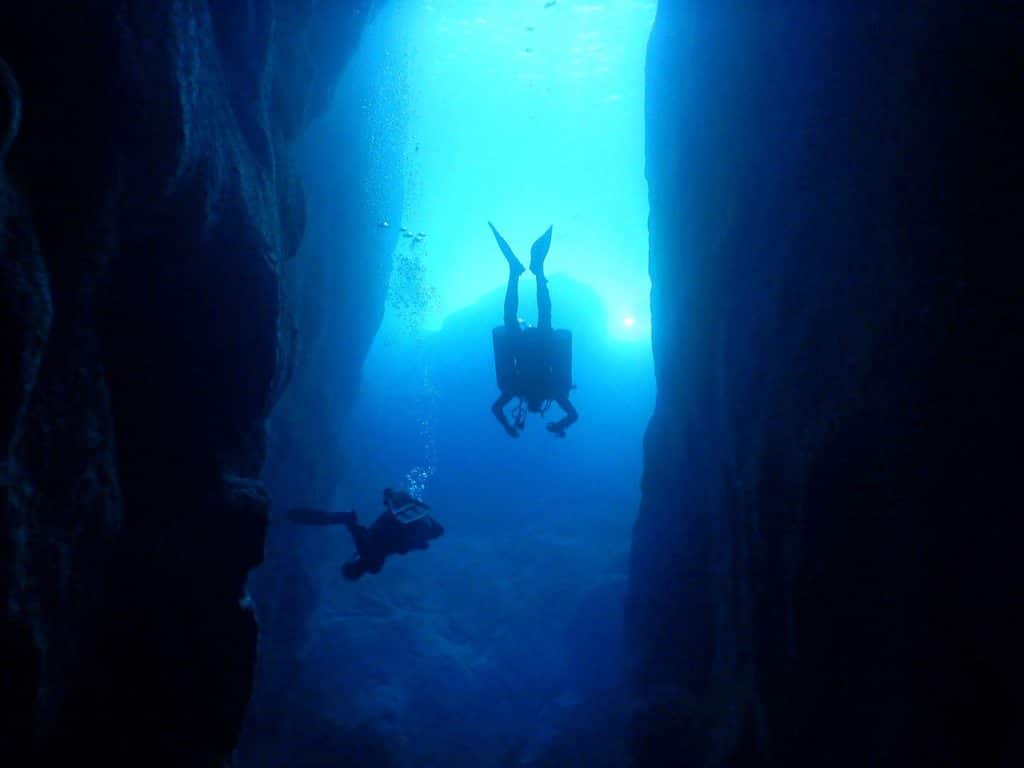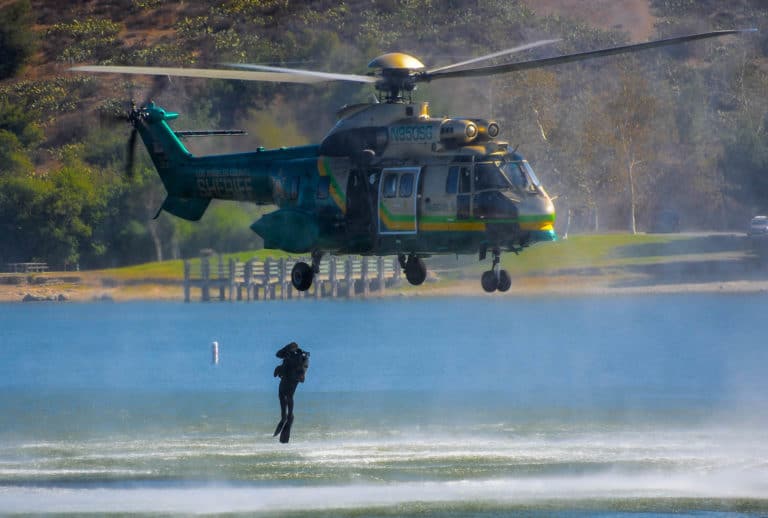UPDATED AUG 2022
Scuba diving is a safe activity but it does have some risks. One of the main risks is boat traffic above the diver. If you are below a certain point and deep enough, then boat traffic is not a major concern as they can drive over you. It will be loud, but safe. However, if you are at a shallow depth, or in the process of descending and ascending from a dive, then this is where there is most risk of a boat running over you. This is why it is important to know what does a diver down flag look like, and why there are two types of diver down flags and what they mean.
Read More: How to Ascend Safety in Scuba Diving
What Does a Diver Down Flag Look Like
A Diver Down Flag indicates that a diver is scuba diving underwater. The diver down flag warns boaters to not come too close to the divers, thus, keeping the divers safe from the boat and propeller when going down or coming up from a dive.
Legally, the diver down flag should be flown from a vessel or a buoy when divers are in the water. From a vessel, the flag should be at least 20 inches by 24 inches and flown from the vessel’s highest point. When the diver down flag is attached to a buoy, the flag should be at least 12 inches by 12 inches.

The Two Types of Diver Down Flags
There are two types of diver down flags that are recognized around the world. The red and white Diver Down Flag is the most highly recognizable scuba diving flag. It is red with a white stripe running across it diagonally. It is used in the water to indicate scuba diving and snorkeling activity close by.
The other diver down flag to know is the blue and white Alpha Flag. This is used internationally to indicate that a boat or vessel has divers in the water. This means the mobility of the vessel is restricted and that other boats should keep clear and lower their speed. This flag is to protect the boat from collisions, while the red and white flag is used more to protect the actual divers.
Diver Flag
Alpha Flag
Using both flags is the safest option, and may be required by law in certain states.
What Must Divers do in their Diving Area?
You should only fly a diver down flag when there are actual divers in the area. As a scuba diver you must assume that boaters and people on the surface do not know that you are underwater.
Scuba divers must adhere to some rules when using a diver down flag. According to the Diver’s Alert Network (DAN) divers must stay within 300 feet (90 meters) of the flag in open water, or 100 feet (30 meters) when diving in rivers, inlets or navigation channels. Divers should also aim to ascend within 150 feet (45 meters) of the diver down flag.
Read More: What Should Divers Do For Their Own Safety?
However, always check local regulations as they may differ. The general rule of thumb is for a diver to stay within 50 feet (15 meters) of your flag, and to ascend no further than 25 feet (7.6 meters) of the flag.
You should only ever fly a diver down flag if there is actual scuba diving or snorkeling activity in the water. You should also ensure that you do not dive or fly the flag in a high boat traffic zone or passageway.
What indicates Scuba Diving or Snorkeling?
These two types of diver down flags indicates scuba diving and snorkeling activity in the water. This is important as you can assume that somewhere great for scuba diving or snorkeling is also great for other water activities such as jet-skiing, wake-boarding, or para-sailing. Because they are going so fast, they may not necessarily see the signs that indicate that there is scuba diving or snorkeling activity. This is why flying a diver flag is very important, and why it may be law to do so depending on your location.
Other signs to indicate scuba diving include: bubbles in the water, flashlights shining underwater, or using a Surface Marker Buoy (SMB) at the end of the dive.
What is a Surface Marker Buoy?
A delayed surface marker buoy (dSMB or SMB) differs from a diver down flag as the SMB is only deployed before a diver ascends from a dive – as opposed to a diver down flag which we know now should be deployed during the whole duration of the scuba dive.
Most typically, the SMB is inflated from below 5 meters / 15 feet at the end of a line from the diver before conducting a safety stop. It is usually long in length and neon in colour (most commonly neon yellow, orange, or red) to ensure it is highly recognizable on the surface of the water, and can be seen in choppy waters.
Delayed Surface Marker Buoy
Typically surface marker buoys are yellow, orange or red, however there are now various other colours such as hot pink, blue, or even black! I typically would still suggest the yellow or orange colours for safety reasons as these colours are most recognized from a far distance.
Do I Need a Dive Flag for Snorkeling?
Don’t assume that because you are on the surface snorkeling that the boats and watercrafts can see you. Many times there will be sunlight reflecting off the water, blinding the captain of a boat. Or, there are waves or ripples on the surface that can hide a snorkeler. Sometimes, snorkelers will even duck dive down a few meters or feet to check out something underwater and be hidden from view!
Read More: How to Snorkel Underwater
This is why it is important to also use a diver down flag in the water and on the vessel/boat when snorkeling. The same flags used for scuba diving can also be used for snorkeling. Legislation in Florida defines ‘divers’ as “a person who is wholly or partially submerged in the waters of the state and is equipped with a face mask and snorkel or underwater breathing apparatus.” This does not include swimmers.
How to Tow a Dive Flag
When using the red and white diver down flag on a float or a buoy, you should stay within 50 feet (15 meters) from your dive flag. If you are venturing further than this distance, you will need to tow your dive flag. Here are some tips for towing a dive flag while scuba diving.
- Use a reel and unspool the line as you descend, keeping it taut. If the line is loose this may get wrapped up and tangled.
- Do not attach the line to your hand or your equipment. If the line is pulled by a strong current or in the worst case, gets tangled and pulled by a boat, then you should drop the line.
- Try to hold the spool/line in your right hand, freeing up your left hand to use the inflator hose to control your buoyancy, and to check your SPG.
- Keep the line at arm’s length so it doesn’t wrap around your tank or hoses.
- You can use a heavy rock, or another object to secure the line if you plan on staying in one spot. Just be mindful to check the rock or object to ensure you don’t damage it or disturb any critters around.
- If you are remaining at the same depth, then use a double-ended clip to ‘lock’ the length so it doesn’t unreel and loose.
- You can also attach a small weight to the bottom on the line to keep it taut and easier to move along while you swim.
- Give it to someone else to tow!
International Scuba Diving Flags
These two types of diver down flags are the international scuba diving flags, and the diver down flag and alpha flags look the same around the world. Divers in the UK will also use the same diver down flags, however, there may be different laws and regulations depending on how far you should stay within the dive flag. It is always recommended to double check local standards and laws prior to your dive.
